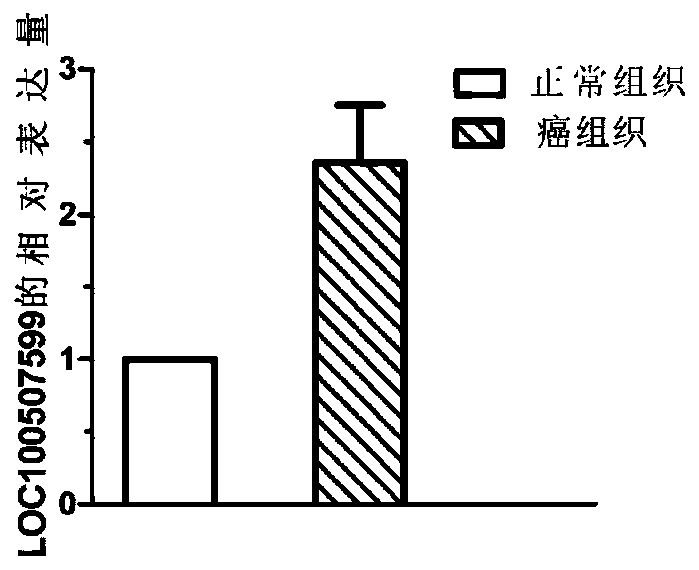Application of non-coding RNA relevant to occurrence and development of laryngeal squamous cell carcinoma
A technology of laryngeal squamous cell carcinoma and reagents, applied in the application field of non-coding RNA
- Summary
- Abstract
- Description
- Claims
- Application Information
AI Technical Summary
Problems solved by technology
Method used
Image
Examples
Embodiment approach
[0033] The invention provides a product for diagnosing laryngeal squamous cell carcinoma, the product includes a reagent for detecting the expression level of LOC100507599, and the product includes a chip or a kit. As an embodiment, the chip includes a solid phase carrier and an oligonucleotide probe that specifically recognizes LOC100507599 immobilized on the solid phase carrier, and the kit includes primers that specifically amplify LOC100507599 and oligonucleotides that specifically recognize LOC100507599 probe or chip.
[0034] The oligonucleotide probe specifically recognizing LOC100507599 may be DNA, RNA, DNA-RNA chimera, PNA or other derivatives. The length of the probe is not limited, as long as it completes specific hybridization and specifically binds to the target nucleotide sequence, any length is acceptable. The probes can be as short as 25, 20, 15, 13 or 10 bases in length. Likewise, the probes can be as long as 60, 80, 100, 150, 300 base pairs or longer, or ev...
Embodiment 1
[0043] Example 1 Screening for gene markers associated with laryngeal squamous cell carcinoma
[0044] 1. Sample collection
[0045] The cancer tissues and corresponding paracancerous tissue samples (more than 1.5 cm from the tumor edge) of 4 cases of laryngeal squamous cell carcinoma were collected for high-throughput sequencing. All patients had not received chemotherapy, radiotherapy and endocrine therapy before operation, and the patients had no other Tumor, cardiovascular and cerebrovascular disease history, infectious disease history and family hereditary disease history.
[0046] 2. RNA sample preparation and quality analysis
[0047] Use the Takara RNA Extraction Kit (Code NO.9767) to extract RNA from the tissue, the steps are as follows:
[0048] 1) Transfer the tissue sample to a liquid nitrogen pre-cooled mortar, grind the tissue with a pestle, and add liquid nitrogen continuously until it is ground into powder. Add the powdered sample into a 1.5ml sterilized centr...
Embodiment 2
[0070] Example 2 QPCR sequencing verification of differential expression of LOC100507599 gene
[0071] 1. The differential expression of the LOC100507599 gene was verified by large sample QPCR of the cancer tissue samples and para-cancerous tissue samples collected from 32 patients with laryngeal squamous cell carcinoma according to the collection method in Example 1.
[0072] 2. RNA extraction
[0073] Takara RNA Extraction Kit (Code NO.9767) was used to extract RNA from tissue, see Example 1 for specific steps.
[0074] 3. QPCR
[0075] Primers were designed according to the gene sequences of LOC100507599 and GADPH, and the primer sequences are shown in Table 1.
[0076] Table 1 Amplification Primer Sequence
[0077]
[0078]
[0079] Using TaKaRa One Step TB Green TM Prime Script TM The RT-PCR kit (Code No. RR066A) was used for PCR reaction, and the reaction system and reaction conditions are shown in Table 2. In Thermal Cycler Perform PCR amplification on t...
PUM
 Login to View More
Login to View More Abstract
Description
Claims
Application Information
 Login to View More
Login to View More - R&D
- Intellectual Property
- Life Sciences
- Materials
- Tech Scout
- Unparalleled Data Quality
- Higher Quality Content
- 60% Fewer Hallucinations
Browse by: Latest US Patents, China's latest patents, Technical Efficacy Thesaurus, Application Domain, Technology Topic, Popular Technical Reports.
© 2025 PatSnap. All rights reserved.Legal|Privacy policy|Modern Slavery Act Transparency Statement|Sitemap|About US| Contact US: help@patsnap.com



